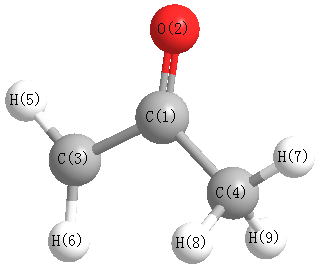Vibrational Frequencies calculated at CCSD(T)=FULL/aug-cc-pVDZ
| Mode Number |
Symmetry |
Frequency
(cm-1) |
Scaled Frequency
(cm-1) |
IR Intensities
(km mol-1) |
Raman Act
(Å4/u) |
Dep P |
Dep U |
|---|
| 1 |
A' |
3271 |
3177 |
|
|
|
|
| 2 |
A' |
3150 |
3060 |
|
|
|
|
| 3 |
A' |
3147 |
3056 |
|
|
|
|
| 4 |
A' |
3028 |
2941 |
|
|
|
|
| 5 |
A' |
1605 |
1559 |
|
|
|
|
| 6 |
A' |
1465 |
1423 |
|
|
|
|
| 7 |
A' |
1448 |
1407 |
|
|
|
|
| 8 |
A' |
1379 |
1339 |
|
|
|
|
| 9 |
A' |
1269 |
1233 |
|
|
|
|
| 10 |
A' |
1053 |
1023 |
|
|
|
|
| 11 |
A' |
916 |
890 |
|
|
|
|
| 12 |
A' |
826 |
802 |
|
|
|
|
| 13 |
A' |
516 |
501 |
|
|
|
|
| 14 |
A' |
375 |
364 |
|
|
|
|
| 15 |
A" |
3103 |
3014 |
|
|
|
|
| 16 |
A" |
1461 |
1419 |
|
|
|
|
| 17 |
A" |
1010 |
981 |
|
|
|
|
| 18 |
A" |
717 |
696 |
|
|
|
|
| 19 |
A" |
497 |
482 |
|
|
|
|
| 20 |
A" |
344 |
334 |
|
|
|
|
| 21 |
A" |
30 |
29 |
|
|
|
|
Unscaled Zero Point Vibrational Energy (zpe) 15305.2 cm
-1
Scaled (by 0.9712) Zero Point Vibrational Energy (zpe) 14864.4 cm
-1
See section
III.C.1 List or set vibrational scaling factors
to change the scale factors used here.
See section
III.C.2
Calculate a vibrational scaling factor for a given set of molecules
to determine the least squares best scaling factor.
